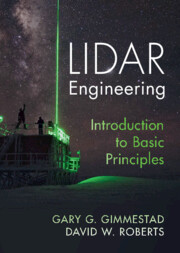Book contents
- Lidar Engineering
- Lidar Engineering
- Copyright page
- Dedication
- Contents
- Preface
- Glossary
- List of Abbreviations
- 1 Introduction
- 2 The Basic Lidar Models
- 3 The Molecular Atmosphere
- 4 Particles in the Atmosphere
- 5 Lidar Transmitters
- 6 Lidar Receivers and the Geometrical Function
- 7 Optomechanics
- 8 Optical Detection
- 9 Data Systems
- 10 Lidar Data Analysis
- 11 Applications
- Appendix A The Klett Retrieval
- Index
- References
1 - Introduction
Published online by Cambridge University Press: 16 February 2023
- Lidar Engineering
- Lidar Engineering
- Copyright page
- Dedication
- Contents
- Preface
- Glossary
- List of Abbreviations
- 1 Introduction
- 2 The Basic Lidar Models
- 3 The Molecular Atmosphere
- 4 Particles in the Atmosphere
- 5 Lidar Transmitters
- 6 Lidar Receivers and the Geometrical Function
- 7 Optomechanics
- 8 Optical Detection
- 9 Data Systems
- 10 Lidar Data Analysis
- 11 Applications
- Appendix A The Klett Retrieval
- Index
- References
Summary
A brief overview and description of the atmospheric lidar measurement technique is followed by the structure of the atmosphere in terms of the troposphere, stratosphere, and mesosphere, as it is usually presented in atmospheric science and meteorology. The atmosphere is then described in terms of lidar observables at all altitudes, including water vapor; trace gases; clouds; several other kinds of particulate matter; and metal atoms, as well as density, temperature, and winds. Examples of lidar measurements include tropospheric and stratospheric ozone, greenhouse gases, other pollutants, tropospheric and stratospheric aerosols, polar stratospheric clouds, and atoms of sodium, potassium, calcium, and iron in the mesosphere. Finally, the structure and contents of the book are described, and suggestions for further reading are given.
- Type
- Chapter
- Information
- Lidar EngineeringIntroduction to Basic Principles, pp. 1 - 12Publisher: Cambridge University PressPrint publication year: 2023



